We all know that magnification increases if we stack two or more close-up lenses together. The same holds true if we stack two teleconverter lenses. In general, if one converter has power A and the other has power B, stacking them together would yield a teleconverter of power A×B. For example, the Sony VCL HGD1758 and Olympus TCON-14B have powers 1.7X and 1.45X, respectively. If we can find some way to stack them together, the resulting lens will have a power of 2.465X = 1.7×1.45.
But, what is "stacking lenses" anyway. Actually, it is very simple. We just connect a number of teleconverters together. Because the combo has a higher power, it extends the focal length of the camera lens. The following shows an extreme example: a Sonly VCL HGD1758, an Olympus TCON-14B and a Nikon TC-E15ED 1.5X teleconverters are connected together, forming a "new" teleconverter with a power of about 3.7X = 1.7×1.45×1.5. This combo is mounted on a Nikon Coolpix 5700, and extends the longest focal length of the 5700 from 280mm to 1035mm!
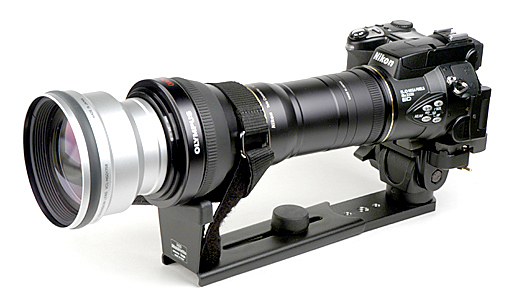
|
However, stacking teleconverter lenses does have some drawbacks.
Given the above reasons, unless you can live with a lower image quality, can find two good teleconverter lenses and mounting mechanism that will not cause vignetting, and do not mind the weight and size, you perhaps would not go into this stacking teleconverter lenses direction.
To illustrate the above points, two very good teleconverter lenses are used: the Sony VCL HGD1758 and Olympus TCON-14B. Click here for more information about these two lenses. The Sony VCL HGD1758 does not have a front thread, and the TCON-14B has a 86mm front thread. This prevents us from putting the TCON-14B in front of the higher power Sony VCL HGD1758. I managed to find a 86-77mm step-down ring. Therefore, a 86-77mm step-down ring, a 77-72mm step-down ring and a 72-58mm step-down ring are used to mount the Sony VCL HGD1758 in front of the TCON-14B. Of course, the use of three step rings is not very promising because they push the Sony VCL HGD1758 away from the Olympus TCON-14B. However, this is the only choice I have. The left image below shows the huge combo, and the combined power is 2.465X = 1.7×1.45. Since the Minolta ACT-100 1.5X also has a 86mm front thread, it can be used with the Sony VCL HGD1758 as well. The right image below shows this combo with a combined power of 2.55X = 1.7×1.5. Since TCON-14B has a better center resolution than the Minolta ACT-100, I chose the TCON-14B for this test.

|

|
| Sony VCL HGD1758 and Olympus TCON-14B | Sony VCL HGD1758 and Minolta ACT-100 1.5X |
With this combo mounted on a FZ-10, since its power is 2.465X, the longest combined focal length of a FZ-10 is 1035.3mm = 2.465×420!
With this combo mounted on a FZ-10, it is huge and longer and heavier than the Panasonic DMW-LTZ10 teleconverter lens. The left image below shows this combo mounted on a FZ-10 with the help of a Chen adapter. Since this is a huge and heavy combo and since the tripod hole of the FZ-10 is not on the line of view of the lens, a lens support is needed so that the combo and the camera can be settled on a tripod in a balanced way. The right image below shows the combo mounted on a Bogen/Manfrotto 3420 Telephoto Lens Support. This is the only lens support of good quality I can find. But, this Bogen lens support has a minor problem. Since FZ-10's tripod hold is not on the line of view, when the combo is mounted on this Bogen lens support the camera and the tripod mounting bar are not aligned in parallel. In other words, the line of view of the lens and the tripod mounting bar make an angle. This is usually not a problem; one just needs some effort to get used to it.

|
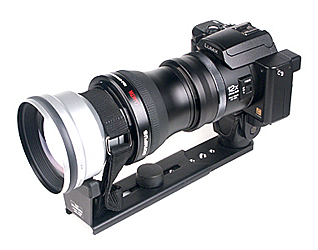
|
To see how good the resolution of this combo is, I framed a tree trunk at the center and took a shot. This is shown in the left image below. In order to see the sharpness near the edge area, another shot was taken by first focusing on the tree trunk and then recomposing so that the trunk is at the right edge. This is shown in the right image below. The images used ISO 50 and LOW for CONTRAST, SATURATION and SHARPNESS. Thus, comparing the images with the trunk at the center and at the right edge would give us a sense of sharpness difference. It is not difficult to see that the very center portion is sharp. Outside of this 1/9 area of the image, the result seems soft and image quality deteriorating quickly toward the border. The right edge portion may show some sharpness; however, the image quality is getting much worse near the right edge.

|
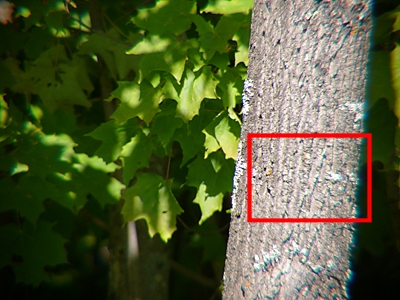
|
| Center Portion (F5.6 and 1/125 sec) | Right Edge (F5.6 and 1/160 sec) |
| Click on the image to see a full size version | |
The center area of the left image above, as marked by the red frame, is cropped and shown in the left image below. Similarly, the right image below shows approximately the same area (of the tree trunk) of the right image above. Now, it is very clear that the center sharpness and edge sharpness of the combo have a huge difference, because the two 100% crops are basically the same area. Some chromatic aberration appears in the form of purple fringes. If the scene contains high contrast areas, chromatic aberration will be even more significant. Moreover, contrast is also lower!
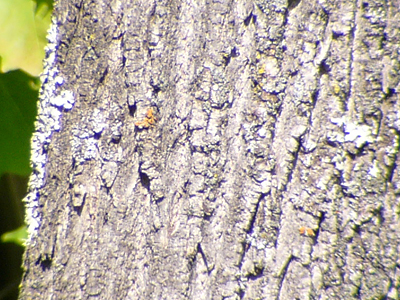
|
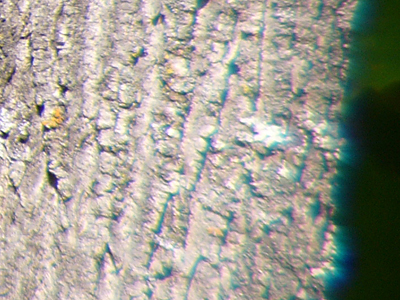
|
| Center Portion | Right Edge |
| Click on the image to see a 100% crop | |
The above shots show the sharpness difference at the center and edge. In summary, if you wish to have some fun, stacking two or more teleconverters would definitely be interesting. However, the results may not be as good as you expected. In general, the sharpness is only good at the center small area, and contrast and resolution power are usually lower than expected. If your work can sustain a significant crop and/or you only use the images in small size, stacking teleconverter lenses may still have some good values.